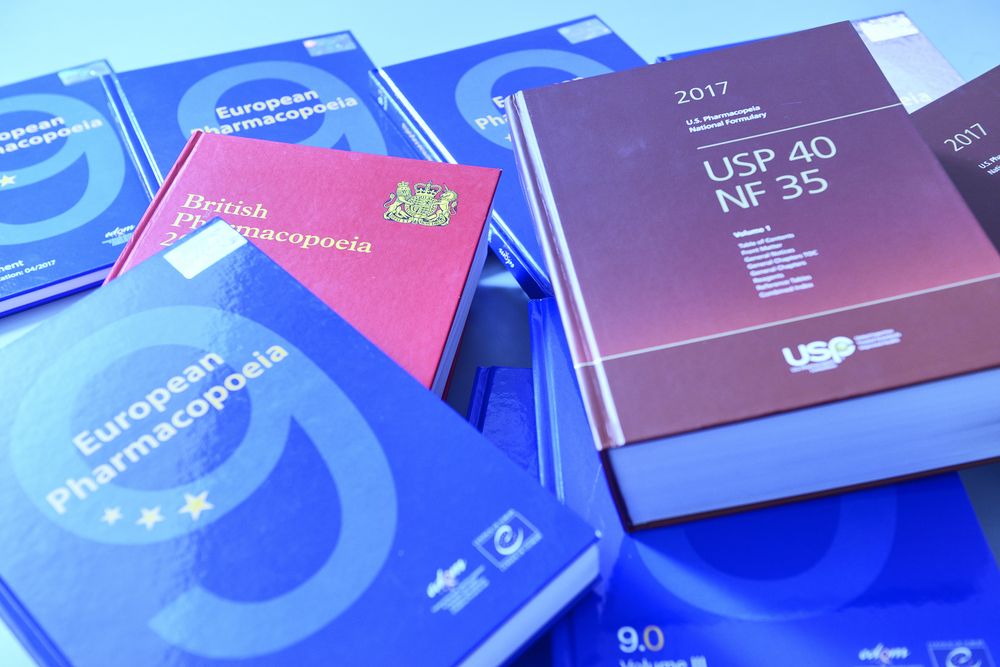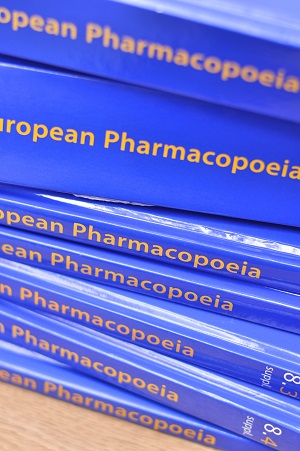2.3.1 Identification reactions of ions and functional groups

Farmakopéanalyser
En farmakopé är en auktoriserad lista över läkemedel med fastsatta standarder för råvaror och produktionsmetoder.
Farmakopén beskriver även gällande kvalitetskrav för farmaceutiska API och hjälpämnen och hur kvalitetskraven för dessa ska utföras.
Att utföra farmakopé analyser kräver specialiserad kunskap och utrustning – och det har vi på DB Lab.
Vi utför både hela farmakopéanalyser eller efter utvalda delar allt efter kundens behov.
Vi utför analyser efter följande farmakopéer:
- Ph. Eur – Europa
- USP – USA
- JP – Japan
- BP – Storbritannien
Här är en lista över de farmakopéer vi på DB Lab utför regelbundet:
2.2. Physical and physiochemical methods
2.2.1 Clarity and degree of opalescence of liquids
2.2.2 Degree of coloration of liquids
2.2.3 Potentiometirc determination of pH
2.2.4 Relationship between reaction of solutions, approximate pH and colour of certain indicators
2.2.5 Relative density
2.2.6 Refractive index
2.2.7 Optical rotation
2.2.8 Viscosity
2.2.9 Capillary viscometer method
2.2.10 Viscosity - Rotating viscometer method
2.2.11 Distillation range
2.2.12 Boiling point
2.2.14 Melting point - capillary method
2.2.15 Melting point - open capillary method
2.2.18 Freezing point
2.2.20 Potentiometric titration
2.2.21 Fluorimetry
2.2.22 Atomic emission spectroscopy (AAS)
2.2.23 Atomic absorption spectrometry (AAS)
2.2.24 Absorption spectrophotometry, infrared (IR)
2.2.25 Absorption spectrophotometry, ultraviolet and visible (UV / VIS)
2.2.27 Thin-layer chromatography (TLC)
2.2.28 Gas chromatography (GC)
2.2.29 Liquid chromatography (e. g. HPLC)
2.2.30 Size-exclusion chromatography
2.2.32 Loss on drying
2.2.35 Osmolality
2.2.36 Potentiometric determination of ionic concentration using ion-selective electrodes
2.2.38 Conductivity
2.2.43 Mass spectrometry
2.2.46 Chromatographic separation techniques
2.2.56 Amino acid analysis
2.2.57 Inductively coupled plasma-atomic emmision spectrometry (ICP-AES)
2.2.58 Inductively coupled plasma-mass spectrometry (ICP-MS)
2.2.60 Melting point - instrumental method
2.2.65 Voltametric titration
2.3 Identification
2.3.2 Identification of fatty oils by thin-layer chromatography
2.3.3 Identification of phenothiazines by thin-layer chromatography
2.4 Limit tests
2.4.1 Ammonium
2.4.2 Arsenic
2.4.3 Calcium
2.4.4 Chlorides
2.4.5 Flourides
2.4.6 Magnesium
2.4.7 Magnesium and alkaline-earth metals
2.4.8 Heavy metals
2.4.9 Iron
2.4.10 Lead in sugars
2.4.11 Phosphates
2.4.12 Potassium
2.4.13 Sulfates
2.4.14 Sulfated ash
2.4.15 Nickel in polyols
2.4.16 Total ash
2.4.17 Aluminium
2.4.18 Free formaldehyde
2.4.19 Alkaline impurities in fatty oils
2.4.21 Foreign oils in fatty oils by thin-layer chromatography
2.4.22 Composition of fatty acids by gas chromatography
2.4.23 Sterols in fatty oils
2.4.24 Identification and control of residual solvents
2.4.25 Ethylene oxide and dioxan
2.4.26 N,N-Dimethylaniline
2.4.27 Heavy metals in herbal drugs and fatty oils
2.4.28 2-Ethylhexanoic acid
2.4.29 Composition of fatty acids in oils rich in omega-3 acids
2.4.30 Ethylene glycol and diethylene glycol in ethoxylated substances
2.4.31 Nickel in hydrogenated vegetable oils
2.4.32 Total cholesterol in oils rich in omega-3 acids
2.5 Assays
2.5.1 Acid value
2.5.2 Ester value
2.5.3 Hydroxyl value
2.5.4 Iodine value
2.5.5 Peroxide value
2.5.6 Saponification value
2.5.7 Unsaponifiable matter
2.5.8 Determination of primary aromatic aminonitrogen
2.5.9 Determination of nitrogen by sulfuric acid digestion
2.5.11 Complexometric titrations
2.5.12 Water: semi-micro determinations
2.5.13 Aluminium in adsorbed vaccines
2.5.14 Calcium in adsorbed vaccines
2.5.15 Phenol in immunosera and vaccines
2.5.16 Protein in polysaccharide vaccines
2.5.17 Nucleic acids in polysaccharide vaccines
2.5.18 Phosphorus in polysaccharide vaccines
2.5.19 O-Acetyl in polysaccharide vaccines
2.5.20 Hexosamines in polysaccharide vaccines
2.5.21 Methylpentoses in polysaccharide vaccines
2.5.22 Uronic acids in polysaccharide vaccines
2.5.23 Sialic acid in polysaccharide vaccines
2.5.29 Sulfur dioxide
2.5.30 Oxidising substances
2.5.31 Ribose in polysaccharide vaccines
2.5.32 Water: micro determination
2.5.33 Total protein
2.5.34 Acetic acid in synthetic peptides
2.5.36 Anisidine value
2.5.37 Methyl, ethyl and isopropyl methanesulfonate in methanesulfonic acid
2.5.39 Methanesulfonyl chloride in methanesulfonic acid
2.6 Biological tests
2.6.1 Sterililty
2.6.2 Mycobacteria
2.6.12 Microbiological examination of non-sterile products: Microbial enumeration tests
2.6.13 Microbiological examination of non-sterile products: Test for specified micro-organisms
2.6.14 Bacterial endotoxins
2.6.21 Nucleic acid amplification techniques
2.6.27 Microbiological control of cellular products
2.6.31 Microbiological examination of herbal medicinal products for oral use and extracts used in their preparation
2.7 Biological assays
2.7.2 Microbiological assay of antibiotics
2.7.25 Assay of human plasmin inhibitor
2.8 Methods in pharmacognosy
2.8.2 Foreign matter
2.8.3 Stomata and stomatal index
2.8.4 Swelling index
2.8.16 Dry residue of extracts
2.8.17 Loss on drying of extracts
2.8.23 Microscopic examination of herbal drugs
2.9 Pharmaceutical technical procedures
2.9.1 Disintegration of tablets and capsules
2.9.2 Disintegration of suppositories and pessaries
2.9.3 Dissolution test for solid dosage forms
2.9.5 Uniformity of mass of single-dose preparations
2.9.6 Uniformity of content of single-dose preparations
2.9.7 Friability of uncoated tablets
2.9.8 Resistance to crushing of tablets
2.9.10 Ethanol content
2.9.11 Test for methanol and 2-propanol
2.9.12 Sieve test
2.9.35 Powder fineness
2.9.37 Optical microscopy
2.9.38 Particle-size distribution estimation by analytical sieving
2.9.40 Uniformity of dosage units




